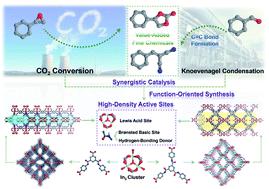当前位置:
X-MOL 学术
›
J. Mater. Chem. A
›
论文详情
Our official English website, www.x-mol.net, welcomes your
feedback! (Note: you will need to create a separate account there.)
Practice of function-oriented synthesis: high-efficiency CO2 conversion and Knoevenagel condensation by two novel In3-based MOFs with high-density active sites under mild conditions
Journal of Materials Chemistry A ( IF 10.7 ) Pub Date : 2022-08-03 , DOI: 10.1039/d2ta03524c Junyi Qiao 1 , Borong Zhang 1 , Lirong Zhang 1 , Yunling Liu 1
Journal of Materials Chemistry A ( IF 10.7 ) Pub Date : 2022-08-03 , DOI: 10.1039/d2ta03524c Junyi Qiao 1 , Borong Zhang 1 , Lirong Zhang 1 , Yunling Liu 1
Affiliation

|
Metal–organic frameworks (MOFs) have shown great potential in catalytic fields, and are especially useful for the chemical fixation of hazardous atmospheric gases to produce value-added products. However, the current difficulties in in situ function-oriented synthesis (FOS) of MOFs result in low efficiencies, as well as huge time consumption and energy cost under high temperature and pressure. Here, based on a FOS strategy targeted at high-efficiency CO2 conversion and Knoevenagel condensation, both of which bear on synergistically catalytic processes, we successfully introduced high densities of multiple active sites, including Lewis acid sites, hydrogen-bonding sites, and Brønsted basic sites, into two novel In3-cluster-based MOFs, JLU-MOF116 and JLU-MOF117. Both compounds feature hwx topology with rhombic open channels, of which these catalytic sites are well distributed in the inner surfaces. Premised on high CO2 uptake capacities under mild conditions, both compounds achieved outstanding catalytic performances in CO2 conversion when compared to a vast majority of MOF materials. Yields, turnover numbers (TONs), and turnover frequencies (TOFs) were high, and even CO2 conversions under a simulated dry flue gas were unexpectedly efficient, as well as Knoevenagel condensation that was performed with high efficiencies. This work provides insight into the structure–function relationship of MOF materials through FOS, which is beneficial for the catalytic field.
中文翻译:

面向功能合成的实践:温和条件下两种具有高密度活性位点的新型 In3 基 MOF 的高效 CO2 转化和 Knoevenagel 缩合
金属有机框架(MOFs)在催化领域显示出巨大的潜力,特别适用于有害大气气体的化学固定以生产增值产品。然而,目前MOFs的原位功能定向合成(FOS)存在效率低、高温高压下的巨大时间消耗和能源成本等问题。在这里,基于针对高效 CO 2转化和 Knoevenagel 缩合的 FOS 策略,这两者都与协同催化过程有关,我们成功地引入了多个活性位点的高密度,包括路易斯酸位点、氢键位点和布朗斯台德位点。基本站点,分为两个新颖的基于3簇的 MOF,JLU-MOF116和JLU-MOF117。两种化合物都具有菱形开放通道的hwx拓扑结构,其中这些催化位点很好地分布在内表面中。与绝大多数 MOF 材料相比,这两种化合物均以温和条件下的高 CO 2吸收能力为前提,在 CO 2转化方面具有出色的催化性能。产量、周转数 (TON) 和周转频率 (TOF) 很高,甚至 CO 2模拟干燥烟道气下的转化效率出乎意料,而 Knoevenagel 冷凝的效率也很高。这项工作通过FOS深入了解MOF材料的结构-功能关系,有利于催化领域。
更新日期:2022-08-03
中文翻译:

面向功能合成的实践:温和条件下两种具有高密度活性位点的新型 In3 基 MOF 的高效 CO2 转化和 Knoevenagel 缩合
金属有机框架(MOFs)在催化领域显示出巨大的潜力,特别适用于有害大气气体的化学固定以生产增值产品。然而,目前MOFs的原位功能定向合成(FOS)存在效率低、高温高压下的巨大时间消耗和能源成本等问题。在这里,基于针对高效 CO 2转化和 Knoevenagel 缩合的 FOS 策略,这两者都与协同催化过程有关,我们成功地引入了多个活性位点的高密度,包括路易斯酸位点、氢键位点和布朗斯台德位点。基本站点,分为两个新颖的基于3簇的 MOF,JLU-MOF116和JLU-MOF117。两种化合物都具有菱形开放通道的hwx拓扑结构,其中这些催化位点很好地分布在内表面中。与绝大多数 MOF 材料相比,这两种化合物均以温和条件下的高 CO 2吸收能力为前提,在 CO 2转化方面具有出色的催化性能。产量、周转数 (TON) 和周转频率 (TOF) 很高,甚至 CO 2模拟干燥烟道气下的转化效率出乎意料,而 Knoevenagel 冷凝的效率也很高。这项工作通过FOS深入了解MOF材料的结构-功能关系,有利于催化领域。











































 京公网安备 11010802027423号
京公网安备 11010802027423号